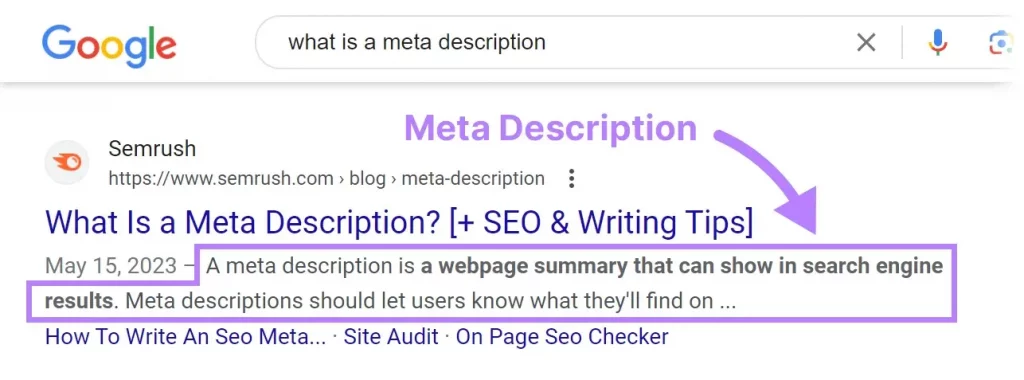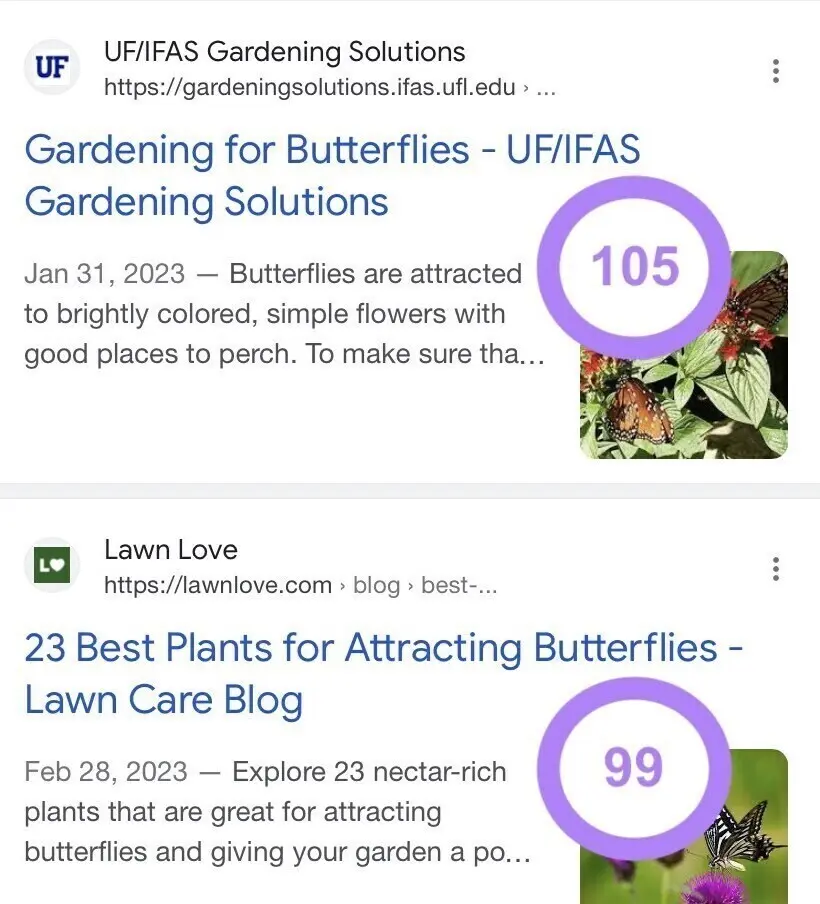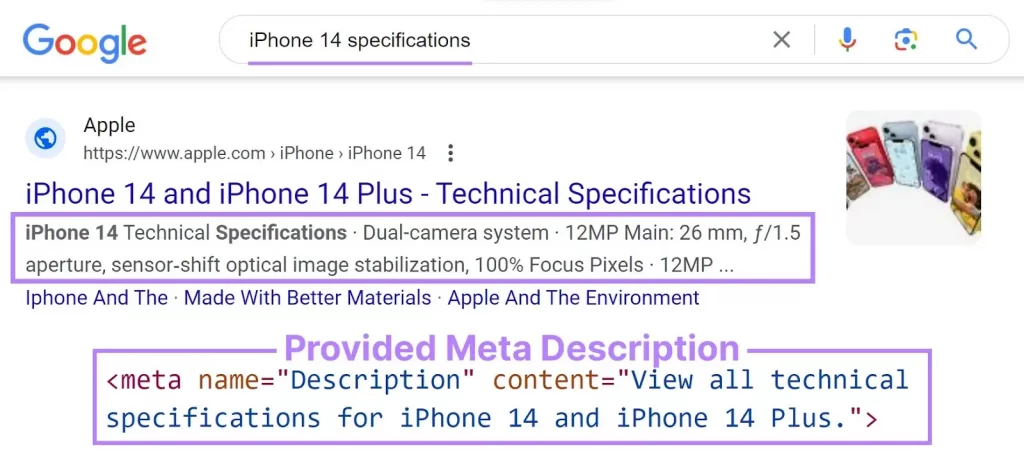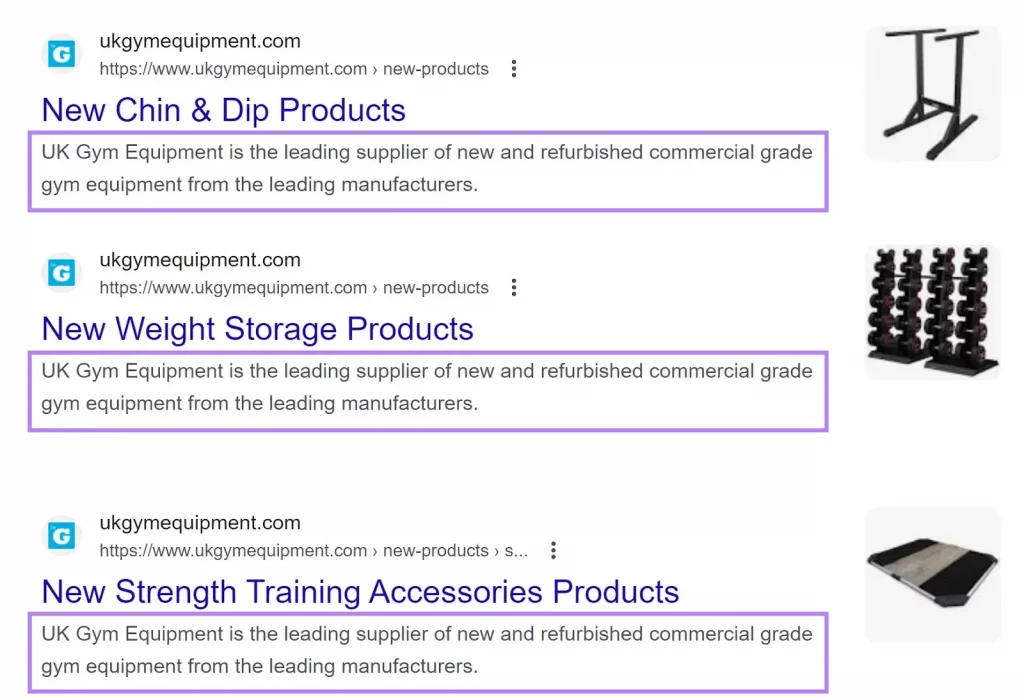Meta descriptions play a crucial role in the world of SEO, acting as a concise preview of what a webpage entails. Crafting compelling meta descriptions is both an art and a science, influencing click-through rates and providing search engine users with valuable insights. In this comprehensive guide, we will delve into the significance of meta descriptions, best practices for writing them, and explore tools and plugins that can streamline the process.
What Constitutes a Meta Description?

A meta description tag serves as an HTML element, delivering a concise overview of a webpage. Positioned beneath the page’s URL and title in Google’s search engine results pages (SERPs), the meta description aids in summarizing the content for users.
In the realm of Google’s SERPs, the search engine autonomously generates a snippet for your pages, drawing from factors like the search query, page content, and the page’s meta description. This ensures that the displayed snippet aligns closely with the user’s search intent.

Essentially, this emphasizes the importance of crafting descriptions that are not only unique but also descriptive and directly relevant to the content of the respective page.
Best Practices for Meta Descriptions:
1. Optimal Length for Meta Descriptions: Aim for 105 Characters (or 680 Pixels)

Are you uncertain about the ideal length for a meta description? Our recommendation is to maintain a meta description length of approximately 680 pixels, which translates to around 105 characters. This provides ample space to craft a compelling summary while minimizing the risk of truncation in the Search Engine Results Pages (SERP).
Although HTML meta descriptions don’t have a strict character limit, Google truncates snippets based on available space. Truncated meta descriptions can negatively impact your Click-Through Rate (CTR), as illustrated in the following example:

In general, Google tends to cut off meta descriptions at approximately 960 pixels (equivalent to around 152 characters) on desktop and 680 pixels (approximately 105 characters) on mobile devices. While you may come across recommendations suggesting a meta description length of 155 characters, the actual number of characters displayed in a snippet can vary due to factors such as the user’s device, character width, and the specific search query.
Tip: Place crucial information near the beginning of your meta description to capture readers’ attention and prevent important details from being truncated.
Learn about the importance of blogs for ecommerce here.
2. Incorporate Your Key Target Keyword Strategically

In meta descriptions, it’s crucial to seamlessly integrate the primary keyword associated with the page—the fundamental search query you aim to rank for. While this practice may not have a direct impact on your Search Engine Optimization (SEO) metrics, it plays a pivotal role in enticing users to click through, especially since Google tends to bold words that align with or are synonymous to the search query.

For instance, consider the target keyword “best trail running shoes.” If this specific phrase is absent from the meta description, potential visitors may perceive the page as irrelevant to their search, potentially diminishing the likelihood of them clicking through to explore the content. Therefore, strategic inclusion of the primary keyword enhances the meta description’s effectiveness in capturing the user’s attention and reinforcing the page’s relevance to their search intent.
3. Cater to User Intent in Your Meta Descriptions
Crafting a compelling meta description involves a deep understanding of search intent—the underlying goal a user aims to achieve with their search query. To create an effective meta description, align your content with what users anticipate seeing when they conduct a specific search.
For instance, consider the search query “buy iPhone.” In response, Apple strategically entices users by highlighting features such as trade-ins and low monthly payments, addressing the user’s inclination towards making a purchase.

On the other hand, when users are in the comparison phase and search for “compare iPhones,” Apple tailors its meta description to inform users that they can explore and compare various iPhone models.

It’s essential to note the adaptability of meta descriptions, exemplified when Google rewrites the meta description for an “iPhone 14 specifications” page. This alteration is driven by the understanding that searchers seeking specific details prefer comprehensive information rather than a vague summary.

Conduct thorough search intent analysis before crafting your meta descriptions. This ensures that your meta descriptions not only capture attention but also reassure searchers that your content aligns with their specific informational needs.
4. Incorporate Persuasive Calls to Action (CTAs)
Enhance the effectiveness of your HTML meta descriptions by integrating compelling calls to action (CTAs) that guide searchers on the desired course of action. These succinct imperative sentences, typically commencing with a verb, serve to prompt user engagement and click-throughs.
Examples of impactful CTAs include:
- Shop online
- Learn more
- Try for free
By employing direct and action-oriented language, your meta descriptions can become more concise, captivating, and persuasive. Consider the transformation in the following example:
Before:
Luggage, travel accessories, and more are available on our website. Complimentary monogramming can be accessed with any purchase.
After:
Shop online for premium luggage & travel accessories. Get FREE monogramming with purchase.
Including well-crafted CTAs in your meta descriptions not only contributes to conciseness but also entices users to click, thereby boosting engagement.
5. Ensure Uniqueness in Every Meta Description
Craft a distinct meta description for each indexable page that may surface on Google’s search results.
By doing so, you provide users with precise insights into the content of each page, ultimately maximizing your Click-Through Rate (CTR).
Generic and duplicated meta descriptions lack value and fail to accurately depict the unique content of individual pages, as illustrated in the example below:

If time constraints hinder manual meta description creation, consider automating the process with AI writing tools like ContentShake AI.
Alternatively, prioritize the creation of meta descriptions for critical pages first, ensuring that essential content receives the attention it deserves while allowing room for comprehensive meta description development in the future.
6. Incorporate Crucial Product Details
When crafting a meta description for a product page, ensure it encompasses essential information regarding the product’s features, benefits, and key statistics. This approach ensures that users clicking on the result align their expectations with the actual content.
A well-optimized meta description for a product page should include:
- The product’s name and model number
- Pricing details, including any discounts or offers
- Salient features and benefits of the product
- Information on product availability and diverse shipping options
By presenting these specifics, your meta description becomes more pertinent and enticing to potential customers.
For instance, consider the following meta description tailored for a product page:

This meta description furnishes users with a comprehensive overview of the product and its specifications. Those seeking such shoes are more likely to choose this result over a generic one that lacks pertinent product information.
Top Meta Description Tools:
1. Site Audit:: Meta Description Analysis Tool
The Site Audit tool is your comprehensive solution for analyzing and optimizing meta descriptions on your website. It performs a thorough examination, identifying and rectifying issues related to missing or duplicate meta descriptions. By enhancing your site’s SEO performance and ensuring a seamless user experience, this tool is an invaluable asset for maintaining an optimal online presence.
Pros:
- Conducts a comprehensive site audit focused on meta description health.
- Efficiently identifies and resolves issues related to meta descriptions.
- Improves search engine visibility and enhances overall website performance.
Cons:
- Limited to site-level analysis.
- Requires a certain level of technical understanding for implementation.
2. On Page SEO Checker: Monitor Google’s Meta Description Display
The On Page SEO Checker is your vigilant watchdog, monitoring how Google displays your meticulously crafted meta descriptions. It empowers you to ensure that your snippets are presented exactly as intended, preventing potential rewrites by search engines. This tool provides real-time insights, giving you greater control over how your content appears in Search Engine Results Pages (SERPs).
Pros:
- Real-time monitoring of meta description presentation by Google.
- Prevents unintended alterations to meta descriptions.
- Enhances control over your content’s appearance in SERPs.
Cons:
- Focuses primarily on monitoring without proactive correction.
- Limited to on-page SEO aspects.
3. Google / Keyword Overview: Analyze Competitors’ Snippets
The Google / Keyword Overview tool offers a deep dive into the meta descriptions used by your competitors. By analyzing and understanding your competitors’ strategies, you can refine and optimize your own snippets for a competitive edge. Stay ahead in your industry by gaining insights into the meta description landscape and leveraging successful approaches.
Pros:
- Comparative analysis of competitors’ meta descriptions.
- Identifies successful strategies to enhance your own snippets.
- Keeps you informed about industry trends.
Cons:
- Limited to competitor analysis.
- Requires manual implementation of improvements.
4. PageImprove: Simplify Meta Description Updates
PageImprove simplifies the process of updating and optimizing meta descriptions on your website. With a user-friendly interface, this tool streamlines the modification of meta descriptions, ensuring accuracy and engagement. Maintain consistent and effective snippet management to elevate your site’s SEO and enhance the overall user experience.
Pros:
- Simplifies the meta description updating process.
- User-friendly interface for quick modifications.
- Facilitates consistent and effective snippet management.
Cons:
- Specific to meta description updates.
- May not cover broader SEO aspects.
5. SplitSignal: A/B Testing for Meta Descriptions
Elevate your meta description strategy with SplitSignal’s A/B testing capabilities. This tool enables you to conduct tests on different snippets, providing data-driven insights for optimizing snippet performance. By identifying the most impactful meta descriptions, you can enhance user engagement and improve click-through rates on your website.
Pros:
- Enables A/B testing for meta descriptions.
- Data-driven insights for optimizing snippet performance.
- Enhances user engagement through effective snippets.
Cons:
- Requires careful planning and monitoring.
- A/B testing may take time to yield conclusive results.
6. To The Web’s SERP Preview Tool: Gauge Meta Description Length
To The Web’s SERP Preview Tool offers a visual representation of how your meta descriptions will appear in Search Engine Results Pages (SERPs). Ensure that your snippets meet optimal length requirements and avoid truncation issues in search results. This tool assists in crafting precise and visually appealing snippets, contributing to better visibility on search engines.
Pros:
- Visual representation of meta description length.
- Helps prevent truncation issues in search results.
- Facilitates precise crafting of snippets for better visibility.
Cons:
- Focuses on length without content analysis.
- Limited to SERP preview functionalities.
Why Meta Descriptions Matter:
Meta descriptions are HTML attributes that summarize the content of a webpage. They appear in search engine results pages (SERPs) and act as a sneak peek, giving users a snapshot of what to expect. Here are key reasons why meta descriptions matter:
- Click-Through Rates (CTR): A well-crafted meta description can entice users to click on your link, directly impacting your CTR.
- User Expectations: Users rely on meta descriptions to gauge whether a page is relevant to their query. Clear and informative meta descriptions set accurate expectations.
- SEO Rankings: While not a direct ranking factor, meta descriptions contribute to a positive user experience, indirectly influencing rankings.
Conclusion:
In conclusion, mastering the art of meta descriptions is pivotal for enhancing your online visibility and driving user engagement. By adhering to best practices, you not only communicate effectively with search engines but also captivate potential visitors. Crafting unique, concise, and compelling meta descriptions tailored to each page ensures that users are enticed to click through, boosting your Click-Through Rate (CTR) and positively impacting search engine rankings. Leverage the power of AI tools like ContentShake AI for efficient meta description generation, and prioritize this task for key pages to optimize your online presence.
FAQs on Meta Descriptions:
Can I exceed the recommended meta description length without consequences?
While there isn’t a strict character limit, exceeding the recommended length may result in truncation on search engine results pages (SERPs). It’s advisable to stick to the guidelines to ensure clarity and completeness.
How frequently should I update meta descriptions?
Regularly review and update meta descriptions, especially for dynamic content or changes in your offerings. Keeping information current enhances relevance and user satisfaction.
Are meta descriptions a ranking factor for search engines?
While not a direct ranking factor, compelling meta descriptions contribute to Click-Through Rates (CTR). A higher CTR can indirectly impact rankings, as search engines interpret user engagement signals.



